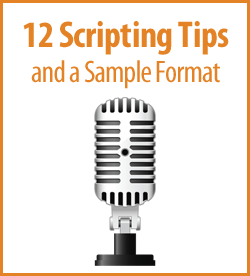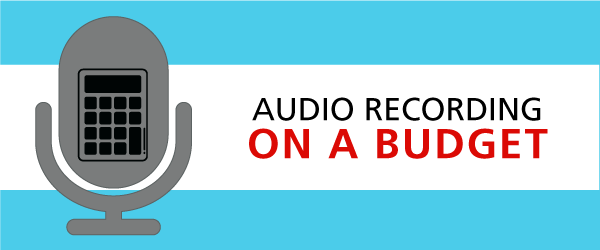If you have limited funds for your production budget, then you may need advice for how to produce audio recording on a budget. As long as you accept the fact that amateur voiceover will not sound like a professional recording, you can still do the best job possible. This article will guide you through the process.
Your Options
Audio recording is something anyone can tackle. When you need audio, you basically have three options. They are:
- Record a colleague on-site at work or remotely
- Hire a professional narrator who can record from home and send you the files
- Use a professional narrator in a recording studio
This article will provide guidance on the first option, for those who need to produce a low budget audio recording.
Tips for A Great Audio Script
Even though the visual aspect of eLearning is its dominant feature, the audio portion is the timeline that carries it along. Writing for narration involves writing for the ear. Some quick guidelines for writing voiceover scripts include:
- Write like people speak
- Use shorter sentences than you would for a document that is to be read
- Use a conversational tone; scripts can be somewhat less formal
- Avoid tongue twisters and word combinations that are difficult to pronounce
- Re-read the script aloud several times and revise each time
- For eLearning, organize the script so that each slide in the authoring tool has its own audio file. If there are interactions that involve audio feedback, you’ll usually need to save each audio feedback as its own file too.
- Give each audio file a unique and logical identifier (Example: The file name can be the module or lesson and slide number, such as m1l2s3.wav
Fore more on this, see The Art of Writing Great Voice Over Scripts.
Finding the Victim Voice Talent
If your workplace is on a physical site, one of the best ways to find a rich voice for in-house recording is to walk up and down the hallways and listen to the conversations. Who’s voice stands out? If working remotely, notice the quality of voices that stand out at meetings.
If you hear a voice that sounds full and smooth, try to convince the owner of this voice to become your narrator. You’d be surprised at how many people are flattered by the request. (You may not want to mention it is hard and tedious work.)
Alternatively, some courses are best narrated by a well-respected expert in your organization. If the person has decent elocution and tone, he or she may be your best choice. If all else fails, you may have to fulfill the role of talent yourself.
Hardware and Software Required
Amateur level audio recording and editing does not have a particularly steep learning curve.
Hardware
A few popular and less expensive mics for in-person recording are listed below:
- Blue Yeti
- Audio Technica AT2020 (or other Audio Technica mics)
- For a lower cost option, try a headset mic that plugs into a USB port, such as one of the Microsoft Life Chat mics.
Software
- For free recording software, most people recommend Audacity for Mac and Windows.
- Many authoring tools come with recording capabilities. For example, Articulate Storyline and Adobe Captivate have a recording mode in which the narrator is recorded directly into the authoring tool. This will not give you the functionality of true audio recording software.
- An upgrade would be Adobe Audition, which you can buy on a subscription basis.
On-site Recording
If you are recording in person, find the most soundproof room in your building. Notice if there are subtle noises that we often don’t hear, such as sounds from the air vent or electronic equipment. At one low-budget recording I attended, someone taped a piece of copy paper over the air vent to lessen the sound. Sometimes you have to come up with creative solutions.
Remote Recording
All of the remote video meeting tools, like Zoom, provide recording functionality. However, some third party apps or services provide two tracks if you are recording two voices in conversation. That allows you to edit the audio of each individual separately. These are typically used for podcast recording, but there’s no reason why they can’t be used for voiceover for other formats.
- eCamm Call Recorder for Skype
- Zencastr
- SquadCast
Reality Check
You already know that an in-house recording of a colleague speaking into a cheap headset is not going to have the sound quality of a movie trailer voice. But in-house recordings will suffice when your budget is limited and when you have few resources. If you will need to make frequent revisions, in-house recording is quite convenient. It is also an excellent way to get started with audio, to experiment and to learn.
Get the latest articles, resources and freebies once a month plus 12 Scripting Tips.



Thanks for your interesting comment, Margo. I often develop courses on serious topics, too. I agree that a conversational tone adds a user-friendly appeal to some of those heavier subjects.
Connie
I just happened by, and this topic struck an aural nerve! I have two new IDs who are new to scripting audio and video. Your tips on this site sound much like those I have been giving them. We deal with serious subject matter which is not exactly light. But that doesn’t mean we need to sound like a bunch of humorless stiffs. We can not only be dignified but also personable, at the same time. I once had an ID who insisted on using words like Moreover and Hitherto, etc., and let’s just say that just wasn’t it. I rehearse my narrators and always find I am editing the script as they read so that the word flow sounds more natural and conversational. Things just sound different when a script is read aloud to others. Sometimes I make edits, but often it’s the narrator who says, “this just sounds funny – it’s not me.” But we do that editing dance until we get it right and have a winner.